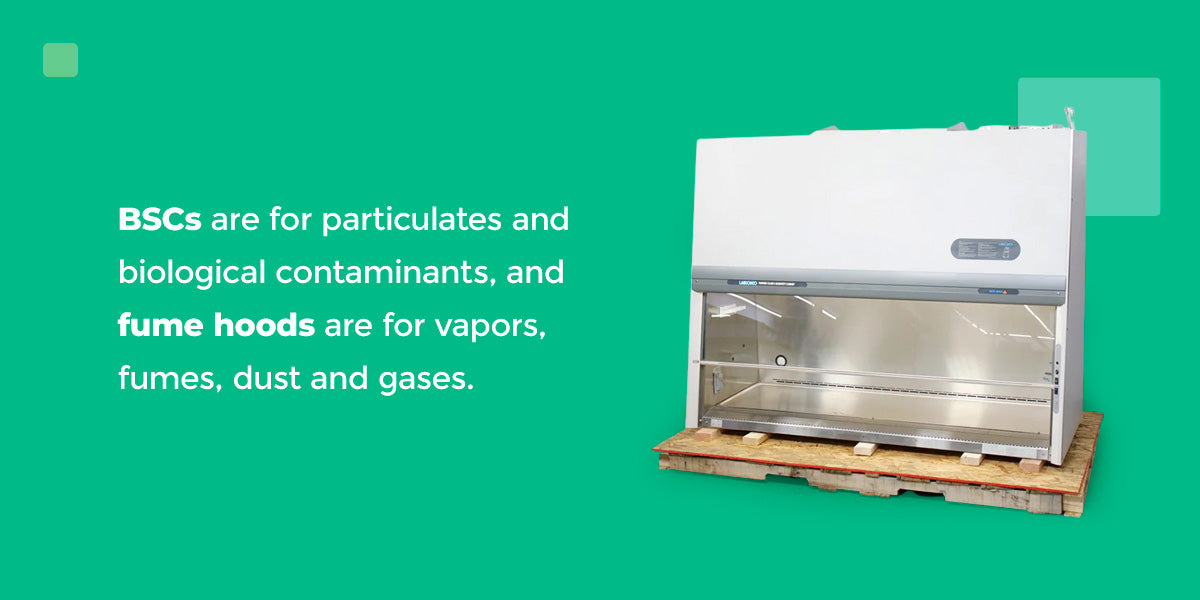Terminology and Specifications for Laboratory Safety Equipment
Familiarizing yourself with common terms and specifications for this lab safety equipment can help you form a better understanding for comparison.
- Airflow intake velocity: The entry of ambient or filtered air into the ventilation system, typically measured in feet per second.
- Ducted system: A system that's connected to ducts for removing contaminants or hazardous substances.
- Ductless system: A system without ducts that uses carbon filtration to remove contaminants and recycle air into the surrounding atmosphere.
- HEPA filtration: High-efficiency particulate (HEPA) air filtration — a pleated filter that meets industry standards for particulate removal.
What Are Biosafety Cabinets?
Biosafety cabinets (BSCs) are ventilation systems that create a safe workspace for research using hazardous particulates and infectious microorganisms that require containment.
All BSCs feature HEPA filtration to protect personnel. Depending on their classification, they may also protect samples and the environment. BSCs fall into separate classes — Class I, II and III.
Class I
Class I models draw air across a work surface and away from personnel. Unfiltered air enters the cabinets, so these options don't protect products. Labs often choose this class for tissue homogenization, cage dumping or culture aeration.
Class II
Class II BSCs are the most popular and are further organized as Type A, B or C1. These options take air around the user and direct it under the work surface before filtering and venting. The airflow pattern protects personnel, products and the environment. These BSCs, certified to standards set by the National Sanitation Foundation and the American National Standards Institute, are perfect for applications involving Risk Group 1 through 4 microorganisms.
- Type A options recirculate a portion of the HEPA-filtered air unless your application requires outside venting, such as work with odorous substances. Based on the minimum average airflow intake velocity, this equipment further qualifies as Type A1 or A2.
- Type B BSCs typically have hard ducting to externally vent filtered air via a per-cabinet exhaust. Type B1 recirculates a percentage of filtered air, while Type B2 exhausts 100% of the air, making it compatible with small volumes of more toxic agents.
- Type C1 options are versatile and can operate as Type A or Type B, either connecting to the ductwork or recirculating air accordingly.
Class III
Class III BSCs are gas-tight and offer the most protection. HEPA filtration occurs with intake and exhaust through a double-filter setup or a filter and air incinerator combination. The cabinet features a closed design with user access via a built-in pair of heavy-duty rubber gloves that prevent direct contact. These traits make them ideal for applications that involve highly infectious substances or pathogens.
The Role of Fume Hoods in Lab Safety
Fume hoods protect personnel from aerosols, mists, fumes, dust and vapors rather than particulates. Two primary types exist — ducted and ductless. Ductless fume hoods may be viable for low-volume use of certain chemicals that naturally evaporate, while ducted models can handle more substances and higher volumes.
This equipment promotes safer research and experimentation with volatile substances, reactive materials, corrosives, flammables and odorous chemicals. Understanding and enforcing proper operation is also essential for safety.
Fume hoods are designed differently to safeguard against inhalation and don't contain HEPA filters, blowers or motors. Instead, this equipment works via pressure dynamics, drawing air away from the user and into the hood with airflow entry through a front opening called the sash. Sashes may be vertical, horizontal or combination sliding to adjust the opening and control intake.
After the hood contains the fumes, the system vents externally in ducted models or filters and recirculates the air in ductless options.
Comparing Biosafety Cabinets and Fume Hoods
Although they may look similar, there are several key differences between biosafety cabinets and fume hoods that make them non-interchangeable.

Key Differences in Design and Application
When comparing BSCs and fume hoods, note the following:
- Contaminants contained: BSCs are for particulates and biological contaminants, and fume hoods are for vapors, fumes, dust and gases.
- Protection level: Fume hoods only protect personnel, while BSCs can protect the person, product and environment. Using personal protective equipment is a best practice when working with fume hoods and is required for biosafety cabinets.
- Filtration mechanism: BSCs use HEPA filtration, while fume hoods rely on carbon or outside exhaust.
- Ideal applications: Typical uses for BSCs include handling biological dangers and infectious materials, cell culturing and hazardous medication preparation. Fume hoods are best for common applications like education, research and forensic science.
- Airflow technology: Fume hoods direct airflow away from personnel and either recirculate it or discharge it outdoors. BSCs employ a unidirectional airflow with filtered air either removed or recirculated.
Can a Fume Hood Be Used as a Biosafety Cabinet?
The short answer is no. While these systems share similar goals — safety and protection — their designs, applications and function differ substantially.
In BSCs, air flows through the built-in HEPA filtration system in the process specified by the equipment's class. Laminar flow hoods also rely on HEPA filtration but provide no personnel protection, so they're unsuitable for working with hazardous substances. Fume hoods contain no HEPA filtration and don't offer environmental protection. As a result, substituting a fume hood for applications requiring environmental protection would be dangerous and violate safety protocols.
Making the Right Choice for Your Laboratory
There are numerous factors to consider when deciding between biosafety cabinets and fume hoods.
Safety is the priority, so you'll want to align your choice with your application. For example, a fume hood may be better if your work regularly involves hazardous chemical vapors and gases. Conversely, a biosafety cabinet is ideal if you need to safeguard against particulates. Some BSCs can also protect against certain fumes, so research available options carefully based on your unique circumstances.
Considering what you need to protect is also a determining factor. A biosafety cabinet is the clear choice if sample integrity and environmental protection are essential.
Ensuring Compliance and Safety in Your Lab
Choosing and installing the right equipment for your needs is a crucial lab compliance and safety measure. These systems help protect your team against the health hazards working with biological and chemical samples can cause. They also safeguard against the financial and reputational costs of noncompliance.
As a result, it's vital to invest in high-quality, reliable solutions capable of meeting your workflow needs and supporting your safety and compliance goals.
Improve Your Lab Safety With New Life Scientific
Accurately selecting between BSCs and fume hoods for your lab means prioritizing safety, understanding what protection levels are necessary and aligning your options with your applications.
New Life Scientific is here to help with a complete selection of biosafety cabinets and additional lab equipment to keep moving your science forward. Each instrument we offer is backed by our 90-day warranty and quality tested by our highly trained technicians.
Want expert advice on the best safety equipment for your facility? The New Life Scientific team is happy to provide it. Contact us through our form or call us at 567-292-2752 to discuss your needs.





















